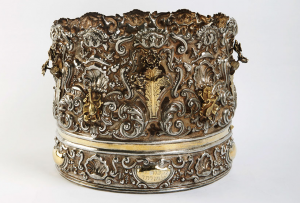VENICE AND THE GHETTO New Display Reveals the Artistic Richness of Jewish Life
It’s the gold that catches the eye, the gilded wood carved to resemble vases filled with flowers, the Baroque handwork shimmering against a wall painted sky blue. Polished wooden benches, once heavy with worshippers, sit empty below closed windows. An iron and brass railing inscribed with Hebrew letters leads to the women’s gallery, quiet behind patterned screens.
This is the Vittorio Veneto Synagogue, built during the 18th century in a small town in northeast Italy, where a small Jewish community congregated for over two hundred years. Similar in style to synagogues in the Venice Ghetto, it was transferred to Israel in 1965 and reconstructed in its entirety by The Israel Museum, Jerusalem. Now it is the centerpiece of a new display, Venetian Splendor: Marking 500 Years of the Venice Ghetto.
The display joins other institutions such as the Doge’s Palace in Venice, the World Jewish Congress, and Princeton University in commemorating the 500th year since the establishment of the world’s first ghetto in Venice in 1516. Gioia Perugia Sztulman, the Italian-born curator of Venetian Splendor, recently spoke about the display at a conference in Venice. “It is a great opportunity to mark this event, so meaningful and crucial in the history of Italian Jewry, with a special display of ceremonial objects from the Museum’s collection, alongside the synagogue of Vittorio Veneto,” she says. “As an Italian Jew, I am glad to bring to the public some of the meanings of ghetto life with all its paradoxes.”
From Warsaw to Harlem, the word “ghetto” has many connotations, but its origin can likely be traced to the Venetian word, “getto,” meaning “foundry.” Indeed, there was once a metal foundry in the area that became the Venice Ghetto; a dirty, poor, overcrowded neighborhood separated from the rest of the city by gates locked between sunset and sunrise. Since Jews in Venice were not allowed to live outside the Ghetto, they established a strong social, cultural, and spiritual life inside it, and shared in a prolific cultural exchange with the surrounding Christian community. Gradually, a variety of Jewish ethnic groups from central and southern Italy, Germany, Spain, and the Ottoman Empire were forced inside the Ghetto, resulting in an ethnic cross section of the Jewish world.
Alongside the Vittorio Veneto Synagogue, Venetian Splendor features elaborately made silver ritual objects such as Torah shields and finials, as well as decorative bindings for prayer books. One such item, a Torah crown created in the 18th century, is decorated with intricate images of musical instruments, demonstrating the prominent role of music in Italian Jewish life. While silver ritual objects made in Venice were purchased by Jewish clients throughout Italy, the profession was forbidden to Jews. Rather, Christian artisans manufactured the items in specialized workshops, often imprinting the silver with an image of the winged lion of Saint Mark, the emblem of the Republic of Venice.
The exhibition also features an ornately embroidered Torah curtain created in 1601, on view at the Museum for the first time. The silk velvet curtain, adorned with silk and gold threads, displays the hand gesture of the priestly blessing, which according to inscriptions, was physician and Rabbi Joseph Coen’s family crest. Notably, trade in second-hand fabrics was one of the few occupations Jews could practice in the Ghetto, which may explain why ceremonial textiles were manufactured with such luxurious materials.
In addition to ceremonial objects, the exhibition showcases the docu-fiction film The Venice Ghetto: 500 Years of Life, directed by Emanuela Giordano, which documents an American Jewish teenager as he explores his Venetian roots and the history of the Venice Ghetto. A photograph by Davide Calimani, courtesy of the Jewish Museum, Venice, provides a bird’s eye view of the Ghetto today, virtually unchanged since its establishment centuries ago.
The French army conquered the Venetian Republic in 1797, ending the Ghetto’s separation from the rest of the Venetian Lagoon. The Israel Museum’s Venetian Splendor: Marking 500 Years of the Venice Ghetto commemorates aspects of the unique Jewish artistry and history that occurred over these two centuries in Venice.

